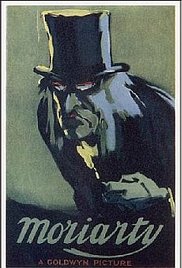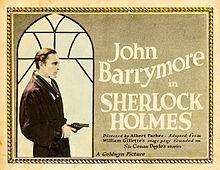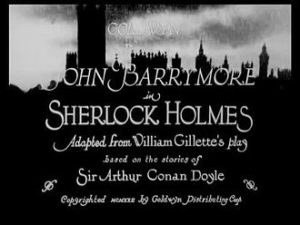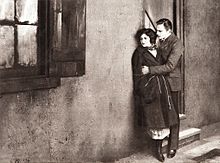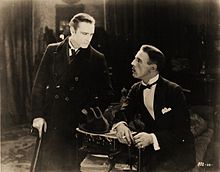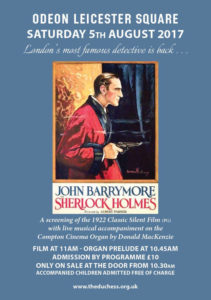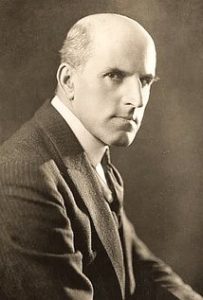Sherlock Holmes [Moriarty] **** (1922, John Barrymore, Roland Young, Carol Dempster, Gustav von Seyffertitz) – Classic Movie Review 5815
Director Albert Parker’s classic 1922 American silent mystery thriller stars John Barrymore as Sherlock Holmes, Roland Young as Dr John Watson, Gustav von Seyffertitz as Professor Moriarty, Carol Dempster as Alice Faulkner and Louis Wolheim as Moriarty’s henchman Craigin. It marks the screen debuts of William Powell and Roland Young.
It is written by Earle Browne and Marion Fairfax, based on the 1899 play by William Gillette and Sir Arthur Conan Doyle’s stories and characters, and is produced by Goldwyn Pictures Corporation.
In the new screen story, Watson asks Holmes to set out to solve a crime involving his fellow Cambridge University student Prince Alexis (Reginald Denny), who is accused of stealing the college athletic funds.
Surprisingly, Holmes falls and is knocked unconscious while in the countryside, and, even more surprisingly, he falls for Alice Faulkner (Carol Dempster), the lovely young woman who rescues him. By chance, she is the sister of Alexis’ girlfriend Rose.
Forman Wells (William Powell) confesses that he took the money to try to get away from the criminal mastermind Moriarty (Gustav von Seyffertitz), and then Holmes seeks to bring down Moriarty. He starts by meeting him face to face, asking to study him.
When his older brothers are killed in a car crash, the Prince has to write to Rose to say he cannot marry her as he is now Crown Prince and must marry a royal, prompting Rose to commit suicide. Holmes holds the Prince morally responsible for Rose’s death and refuses to help him further when Moriarty seeks Rose’s love letters to blackmail him. Holmes intervenes when he learns that Alice has the letters.
Despite the still missing footage which creates some jumps in the narrative, the movie is extremely well and complexly plotted and dramatically satisfying, with some especially strong scenes and a powerful finish. The penalty for the complicated plotting is that the film has rather a lot of title cards to read, which slightly slow down the pace and dynamism. But the mystery is the thing, and the characters and the plot, and they are all well taken care of.
Barrymore is excellent as Holmes. Often bathed in bright light to dark backgrounds, he looks just right, and he underplays but keeps compelling. There are no florid displays of silent acting here. The same is true of Young as Watson. The other big success is Von Seyffertitz, with a lot to do as a splendid Moriarty, looking great and doing all the required lip-smacking villainy while still holding on to it and without going over the top.
The noir-style production is good, with the visuals atmospheric, imaginative and attractive, but with no big florid flourishes here either. It is all very brisk and businesslike, without being extravagant. It feels right.
Also in the cast are Percy Knight as Sid Jones, Hedda Hopper as Madge Larrabee, Peggy Bayfield as Rose Faulkner, Margaret Kemp as Therese, Anders Randolf as James Larrabee, Robert Schable as Alf Bassick, David Torrence as Count von Stalburg, Robert Fischer as Otto, the Prince’s valet and Moriarty’s secret underling, Lumsden Hare as Dr Leighton, Jerry Devine as Billy, John Willardas Inspector Gregson and Walter Kingsford as the gunman in apartment.
The film was thought lost in the 1967 MGM vault fire but was rediscovered in the mid-Seventies and reconstructed in 1975 from material held by George Eastman House by Kevin Brownlow and William K Everson.
Everson recalled the Herculean task of putting it all together: ‘All that existed of this film were rolls and rolls of negative sections, in which every take was jumbled out of order, with only a few flash titles for guidance.’
A second reconstruction incorporating newly found elements was undertaken by Eastman House in 2001.
The 2001 reconstruction was released on DVD by Kino International in 2009, with about 26 minutes of footage still missing. It runs 109 minutes instead of the original 136 minutes.
The film was originally released as Moriarty in the UK.
The original first Broadway performance of William Gillette’s play version, Sherlock Holmes, was produced by Charles Frohman opened at the Garrick Theatre on 6 November 1899 and ran to June 1900. Gillette revived the play numerous times over the years. Gillette previously starred in the 1916 film version Sherlock Holmes, the only preserved record of him playing Holmes. This too was thought lost but was re-discovered, this time in 2014 in the Paris archives of the Cinémathèque Française, which has restored it. The TCM print runs
Gillette gave Holmes his trademark curved pipe after having trouble saying his lines with the straight-stem pipe he has in the books.
Sherlock Holmes (1922) is screened at the Odeon Leicester Square on 5 August 2017, with a perfect accompaniment on the cinema’s Compton organ by Donald MacKenzie, following his 20-minute accompanying Organ Concert prelude. This is a tour-de-force by MacKenzie, particularly the improvised accompaniment, which avoids relying on snatches of classic and old tunes, and sound effects, for it effect. It is very inventive, very smooth, very enjoyable. It accompanies, it doesn’t take over from the movie.
MacKenzie (47) is celebrating 25 years since he first performed at the Odeon. In 1993, he played the organ for five weeks before Disney’s Aladdin. He has played for many Royal Film Performances, several for The Queen.
Here’s the restored movie:
© Derek Winnert 2017 Classic Movie Review 5815
Check out more reviews on http://derekwinnert.com
Gustav von Seyffertitz plays Professor Moriarty.

